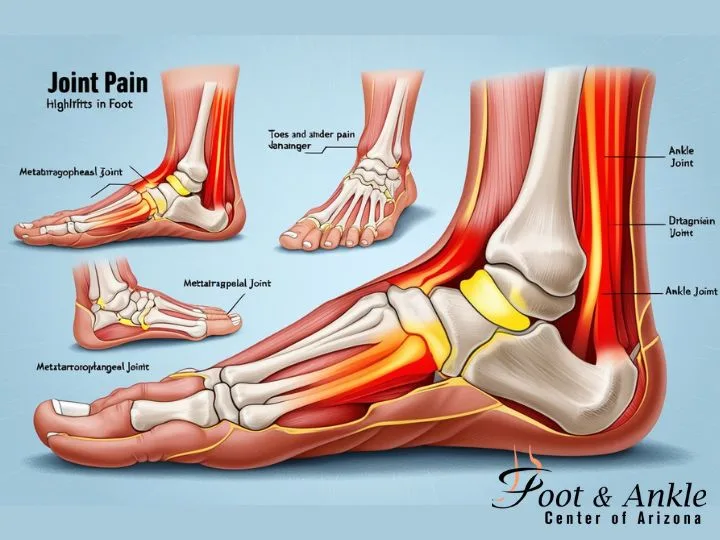Pain in the joints of the foot can pose a serious challenge to everyday living, impinging on mobility and quality of life. With people today being athletes, aged individuals, or those who need to stand for very long periods, there is more of a need to comprehend the causes, symptoms, and available treatments for foot joint pain. A proper management plan is necessary in this scenario. This article serves as a complete guide to foot joint pain in helping you identify the source and explore the available treatment options.
Section 1: Understanding Foot Joint Pain
What is foot joint pain?
Pain in the joints of the foot can be defined as any discomfort or ache that involves the joints of the foot and may be mild or severe. These can present as dull aches, sharp pains, or persistent soreness, affecting one or more joints such as those in the toes, ankles, or midfoot. The pain can be acute, meaning it happens quite suddenly, or chronic, which would mean the pain persists for more than a few months, depending on the cause.
How the Foot Joint Works
The foot is a complex structure made up of 33 joints, 26 bones, and over 100 muscles, tendons, and ligaments. Together, these elements support body weight, absorb shock, and enable locomotion. The joints permit the movement of the bones against each other and are cushioned by cartilage that reduces friction between them. When the cartilage wears down, or in the event of injury, pain to the joint can develop-limiting mobility and creating discomfort.
Section 2: Common Causes of Foot Joint Pain
Injury-Related Causes
Active individuals commonly sustain injury to cause foot joint pain. Common ligament injuries in sprains, especially, and also fractures of small bones, are sustained. Stress fractures and tendonitis are examples of overuse injuries that can also result in foot joint pain. Specifically after extensive repetitive activities like running and jumping.
Arthritis
Arthritis is another leading cause of pain in the joints of the foot. The two most common types to affect the foot include osteoarthritis and rheumatoid arthritis. Where osteoarthritis is an erosion of cartilage over time, allowing bone to rub on bone, rheumatoid arthritis is an autoimmune disease that directly attacks the lining of joints. Gout is a form of arthritis caused by uric acid crystals build up in the joints that often causes sudden, sharp pain in the big toe
Bunions and Other Deformities
Deformed feet, such as bunions, hammertoes, and flat feet can cause painful joints. Bony bumps develop on the joint at the base of the big toe. Bunions most times develop due to displacement of bones in that part of the foot thus increasing pressure on the joint.
Other Conditions
Other contributing conditions include the inflammation of the tissue that connects the heel bone to the toes, or plantar fasciitis, tendinitis, and neural conditions like Morton’s neuroma. It also includes obesity as a contributing factor, because carrying excess body weight is in itself a contributing burden to the joints that worsens pain.
Section 3: Signs and Symptoms of Foot Joint Pain
Common Signs and Symptoms of Foot Joint Pain
The symptoms of foot joint pain can vary but have many presentations including swelling, stiffness, and reddening of the involved joint. Pain in most cases may increase with activities such as walking or standing and can be associated with marked limitation of joint mobility. Notably, the presence of warmth or heat may be felt in the joint due to inflammation.
Course of Symptoms
Many times, the pain in the foot joint starts with a slight discomfort which develops into an unbearable pain when not treated. Chronic pain in the joint has many complications that could arise from it. These complications include a limitation of motion, instability of the joint, and permanent joint damage.
Section 4: Diagnosis of Foot Joint Pain
Physical Examination
The physical examination can be considered a starting diagnostic analysis of foot joint pain doctor will press different parts of the foot to find tender spots, and check joint mobility, swelling, and deformity. Imaging and Diagnostic Device
Imaging studies, such as X-rays, MRI, or ultrasound, may be recommended to provide more detail about the underlying cause of the pain. These tools can assist in diagnosing fractures, torn ligaments, and joint degeneration. Blood tests are used to rule out or confirm autoimmune diseases like rheumatoid arthritis or gout.
Section 5: Treatment Options for Foot Joint Pain
Non-Surgical Treatments
RICE is often the first-line treatment for most minor injuries. Resting the foot, applying ice, wrapping it with compression bandages, and elevating the foot can help reduce pain and swelling.
Medications:
Over-the-counter anti-inflammatory medications, including ibuprofen, are used to manage pain and inflammation; prescription medications may be indicated for conditions such as arthritis.
Physical Therapy:
Exercises that work to strengthen the joint and give it greater flexibility can also be some of the most effective treatments for joints in pain. A physical therapist will guide you through stretches and movements that help affected areas.
Orthotics and Braces:
Custom orthotic inserts or braces can offer additional support and pressure relief from painful joints. These devices will help with proper foot alignment and, consequently, weight distribution.
Surgical Treatments
Arthroscopy:
If the condition is more serious, it may require minimally invasive surgery. Arthroscopy uses small tools to fix joint damage, such as torn ligaments or cartilage.
Joint Fusion:
For serious arthritis, the joint must be fused to provide stability to the joint and decrease pain.
Joint Replacement:
For chronic pain in the joint with a lot of damage, there is the option of joint replacement surgery to return mobility and rid of discomfort.
Alternative Treatments
Other forms of treatment, including acupuncture or massage therapy, may also benefit some patients, along with lifestyle adjustments like losing weight and supporting the feet with good shoes. Such treatments may relate to reducing pain and therefore increasing comfort in the foot.
Section 6: Prevention Tips for Foot Joint Pain
Correct Shoes
Also, it’s best if shoes are supportive and properly fitted. Wear different types of shoes for specific activities, such as running and hiking. And finally, don’t wear high heels and unsupportive flats that can put extra stress on your joints.
Exercise and Stretch regularly
Exercise and stretch your feet regularly to keep them strong and flexible, avoiding joint strain. The exercises to do for your feet and ankles include balance, strength, and range of motion.
Maintaining a Healthy Weight
The less stress your foot joints have to endure, the better. Maintaining a healthy weight will go a long way in reducing the pressure that is always on your foot joints. Excess weight increases the stress on the joints, leading to faster wear and tear.
FAQs: Foot Joint Pain
What are the most common causes of foot joint pain?
Common causes include arthritis, sprain and fracture-related injuries, and other disorders related to bunions or plantar fasciitis.
Can arthritis cause permanent damage to the foot joints?
Yes, arthritis does lead to permanent joint damage with deformities if left in its course; these may then require surgical intervention.
When should I seek advice for foot joint pain?
If the pain continues to persist after several days, progresses with activity. Or is associated with swelling, redness, or warmth, a consultation with a doctor should be considered.
Are there home remedies for foot joint pain?
Mild cases of foot joint pain can be managed by RICE and over-the-counter anti-inflammatory medications.
How long does it take to recover from foot joint pain?
The prognosis depends on the cause. Mild cases generally recover in weeks, while chronic causes, such as arthritis, are symptomatic and may require ongoing management.
Conclusion
The origin of pain in the foot joints may be from injury, arthritis, and deformity. It is very important to diagnose and treat pain at an early stage to prevent complications and to keep the pain as low as possible. There are several treatments for relieving pain in the joints of the foot and restoring mobility: nonsurgical treatments, physical therapy, and surgical treatments for extreme cases. Consultation with a health professional is the best way to deduce the best way forward in managing persistent foot joint pain.
For additional details, please refer to:





